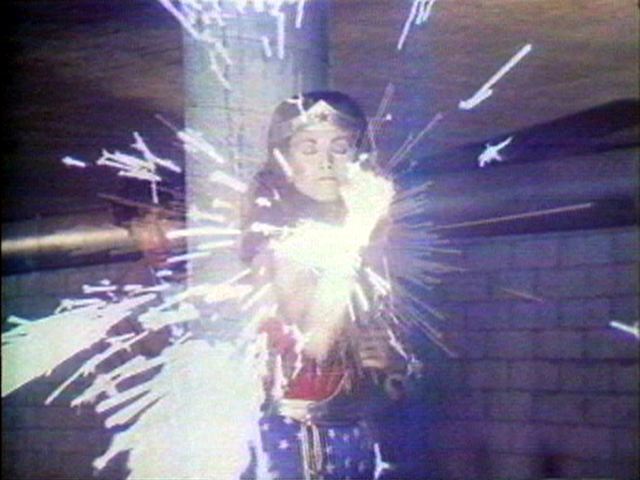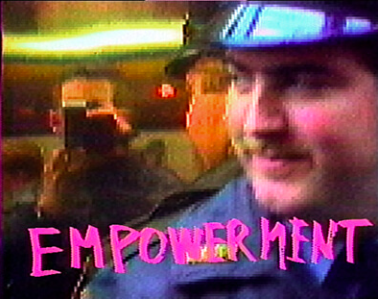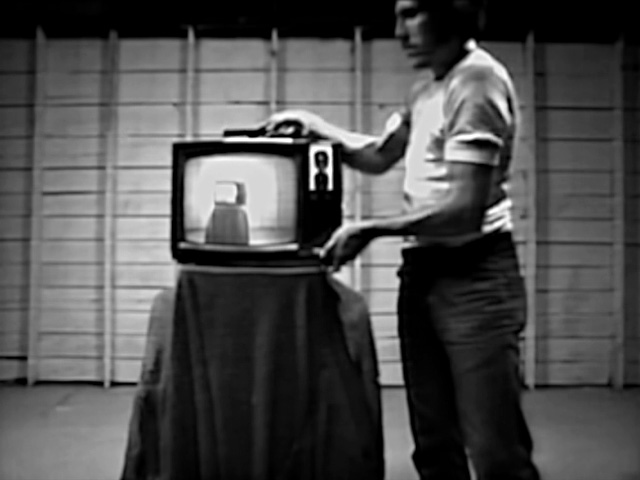The EAI Collection: Artist Index
Artist Index
In Alex Bag's ironic performance videos, the artist adopts a series of personae to create droll conceptual parodies. With her signature deadpan delivery and deliberately low-tech style, Bag mixes the vernacular of pop culture with irreverently humorous monologues. Performing in multiple guises amidst fragments of pop detritus, Bag skewers the tropes of consumer and media culture. Questioning how we define ourselves in relation to television, fashion, advertising and the artworld, she creates mediated parodies that teeter between celebration and critique. EAI is pleased to make available, for the first time, Bag's body of video works from the 1990s and 2000s.
John Baldessari has been termed "one of the most influential artists to emerge since the mid-1960s." From his phototext canvases to his composite photo collages and installations, Baldessari's works have contributed to the definition of postmodern art. In the early 1970s, he produced droll conceptual video works that are ironic investigations into perception, meaning and interpretation, rendered with deadpan, often absurdist humor.
Phyllis Baldino engages in a conceptual art practice that merges performance, video, sculpture and installation. With wit and ingenuity, Baldino uses anecdotal conceptual humor and an implied narrativity to question the function and meaning of everyday objects and gestures. These inquiries, which are often informed by scientific or philosophical principles, have in recent years expanded to include investigations into vision and perception.
Burt Barr's videotapes articulate the interior voice of fiction through a corresponding visual expression. Barr's understated narratives, which include minimalist fiction, wry anecdotes, and nonlinear performance documents, relay their stories through precise, lucid imagery and a spare use of language.
A pioneeer in video technology and image processing, artist and engineer Stephen Beck developed one of the first video synthesizers—the Beck Direct Video Synthesizer—in 1969. Electronically fusing moving color imagery with recorded visual material in real time, Beck created performance collaborations with musicians. In 1974, he designed the Video Weaver, a digital video computer with "warps" and "wefts" based on traditional textile looms. Beck's pure abstractions of moving light and color represent a fusion of art and technology.
Michael Bell-Smith uses digital forms to explore contemporary visual culture and how it is mediated through popular technologies. His work often incorporates the visual vocabulary of the Internet, such as animated gifs and lo-res images, and references the aesthetics and semiotics of common computer programs such as Powerpoint and Web sites such as YouTube. Remixing and reinterpreting sources ranging from industrial videos and music clips to classic cinema and contemporary art, Bell-Smith reconsiders the cultural meaning of these materials in a "post-personal computer, post-Internet, post-Google" age.
A major contributor to contemporary French critical thought, French critic and author Raymond Bellour has advanced the theoretical application of semiotics, psychoanalysis and post-structuralism to the understanding of literary and cinematic texts. In addition, Bellour has also written extensively on contemporary video art and curated several major exhibitions.
Zoe Beloff works across a wide range of media, including film, stereoscopic projection performance, interactive media, installation and drawing. Working with both archaic apparatuses and new analog/digital hybrids, she graphically manifests the mind's unconscious processes. Beloff considers herself a medium, an interface between the living and dead, the real and the imaginary. Aiming to connect the present with the past, she creates new visual languages where, she writes, "modern media will once again be invested with the uncanny." Beloff has collaborated with artists from other disciplines, including John Cale, the Wooster Group, and Shelley Hirsch.
An eminent sculptor and videomaker for more than three decades, Lynda Benglis produced a pioneering body of feminist video in the 1970s. Immediate and visceral, Benglis' video work confronts issues raised by feminist theory, including the representation of women, the role of the spectator, and female sexuality. Benglis also engages the emergent practice of video in an incisive discourse on the production of the moving image.
Since 1994, the anonymous, international group of artists known as Bernadette Corporation has explored strategies of cultural resistance and détournement, appropriating contemporary entertainment modes for their own experimental purposes. From the New York-based BC fashion label, which garnered a cult following in the 1990s, and the magazine Made In USA, launched in 1999, to the collectively-authored novel Reena Spaulings (Semiotexte, 2005) and videos starring the likes of Sylvère Lotringer and Chloe Sevigny, Bernadette Corporation's interventionist projects amount to a precisely-calibrated critique of a global culture that constructs identity through consumption and branding.
As an artist, teacher, and activist, Joseph Beuys is one of the major figures in postwar German art. His theories on the social utility of art influenced a generation of artists. Beuys, who was associated with the Fluxus movement, created conceptual works, objects, drawings, installations, performance "actions" and lectures. These materials featured here chart Beuys' developing relationship with an American audience, from his first tour in 1974 to the 1980s.
Dara Birnbaum's provocative video works are influential and innovative contributions to the contemporary discourse on art and television. In her videotapes and multi-media installations, Birnbaum applies both low-end and high-end video technology to subvert, critique or deconstruct the power of mass media images and gestures to define mythologies of culture, history and memory.
Emmy Award-winning television producer and video artist Skip Blumberg has been an influential figure in the evolution of the independent video documentary and experimental videos. From his seminal guerrilla television work beginning in the late 1960s and early explorations of the graphics of video (JGLNG, 1976) to his recent independent experimental documentary (Growing Up Bonobo: Photographer Marian Brickner, 2015), and performance videos (On Dream Street..., 2012), he brings a distinctive, personal approach to the documentary form that, in his words, "warms up the cool medium of television."
Working in relative obscurity and on an intimate scale, Ante Bozanich produced a powerful body of psychodramatic work exploring the exile of the self in contemporary culture. His early performance-based works feature visceral confrontations with the camera; the Yugoslavian-born artist uses the immediacy and intimacy of video as a psychodramatic construct.
German artist Klaus vom Bruch engages in a provocative analysis of personal and national identity in relation to cultural mythology and history. Vom Bruch constructs rhythmic, repetitive confrontations between the self and collective memory, presented as a theater of appropriated media images — television advertising, Hollywood cinema, military archival films.
In his body of moving image work that spans the mid-1980s to the present, Robert Beck/ Buck merges cinematic, televisual, and visual art aesthetics and strategies to singular effect, paying careful attention to the viewer's experience of his art. From his conceptual cable access television series of the 1980s through his activist works, "alternative" music videos and found-footage pieces, Beck/Buck's privileging of unexpected interpretations is the heritage of an eclectic list of influences, including Marcel Duchamp and Cady Noland, Robert Bresson and George Romero, film theorist Carol Clover and novelist Cormac McCarthy, the true-crime genre, the teachings of Jacques Lacan, and forensic science.
In her video works of the 1970s and '80s, Barbara Buckner employed video and computer technologies to create painterly works of strong visual and symbolic resonance. Her formal explorations of the transformative properties of electronic image-processing technology result in metaphoric works with an otherworldly sensibility.
Chris Burden gained international attention in the 1970s as an influential and often controversial figure in the West Coast body art, performance and conceptual art movements. Investigating the psychological experience of personal danger and physical risk, he used his own body as an art object in outrageous, sometimes shocking acts, aggressively confronting the artist/audience relationship and the artmaking process.
Burns and Martin began their collaborations in the video and sculpture programs at the School of Art and Design at Alfred University. Together, Burns and Martin have based their single channel videotapes and current sculptural works on their research into diverse speculative fictions and re-imagined educational practices.
In the 1970s, James Byrne developed a distinctive, body-based method of image making, in which he used the hand-held portable camera as a gestural extension of the body in a physical exchange with his subject. Byrne explored this aesthetic primarily in innovative video dance collaborations that were choreographed and performed specifically for video.



























